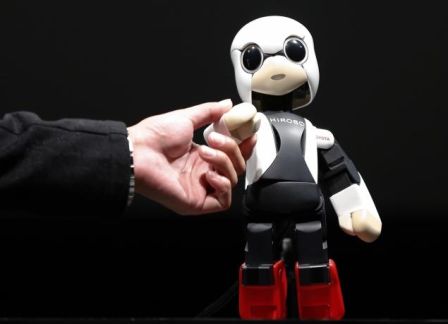On Sunday, the Japan Aerospace Exploration Agency (JAXA) launched Kirobo, the world’s first talking humanoid robot astronaut, into space. The 13.4-inch-tall robot was a result of the Kibo Robot Project, run by the Research Center for Advanced Science and Technology from the University of Tokyo along with Dentsu, Toyota and JAXA.
The name ‘Kirobo’ comes from a combination of the words ‘robot’ and ‘kibo,’ which translates to ‘hope’ in Japanese.
Kirobo was launched from the Tanegashima Space Center with five tons of supplies, food and equipment and will rendezvous with the International Space Station (ISS). JAXA astronaut Koichi Wakata will arrive at the ISS in November. The cargo vehicle carrying the payload separated from the launch vehicle about 15 minutes after takeoff.

Image via NYDailyNews.com
The robot will function as a companion to Wakata. It’s part of the vision of the Kibo Robot Project to increase robot-human communications in response to problems from society becoming more individualistic and less communicative. More people live alone than in previous generations, and the project seeks to find out if robots can be companions to people who are often alone.
Kirobo will also serve a functional purpose, relaying messages between flight control, Earth-based researchers and Wakata. Kirobo is equipped with voice-recognition and natural-language processing technologies and also has facial recognition capability. Conversations with Wakata and Kirobo will be recorded and analyzed by the research team.
If all goes according to plan, the robot will return to Earth in December 2014.
There were 14 tests that Kirobo had to undergo to be ready for space. Some of the more interesting tests deal with issues that we take for granted living on Earth.
The most obvious condition is the reduced gravity at the ISS. Kirobo communicates with hand gestures, so there is a possibility the robot could start spinning in mid-air as the result of these gestures.
Air currents are something always present on Earth, but have to be provided artificially at the ISS. When an object becomes hot, the air around it also becomes hot and rises. The rising air is replaced with new air that is cooler. Thermal testing had to make sure that the artificial air current was enough to keep Kirobo below 120 degrees Fahrenheit. Results found that the temperature reached a maximum of 116 degrees, so that test passed.
Other tests ensured that the robot did not exceed noise levels, could handle voltage drops, vibrations and making sure the robot does not emit toxic gas. EMF testing was also necessary to make sure the robot did not interfere with avionics functionality, just like airline passengers have to comply with.
The sophistication of Kirobo’s robotics is remarkable, given the tests it had to pass to be allowed on the ISS. It will also be interesting to find out what the results are from the human-robot interaction during the mission. For the first time, it looks like some of the technology of past science-fiction movies is starting to operate in real life.
Edited by Alisen Downey
